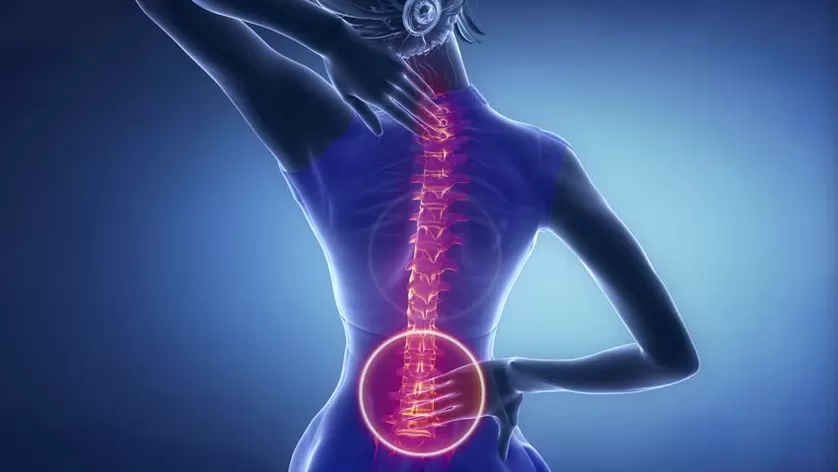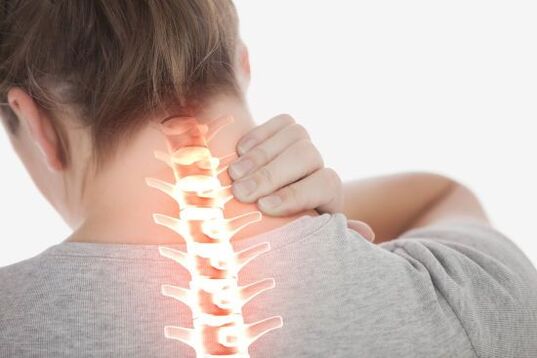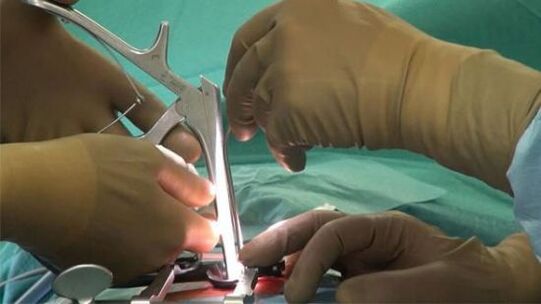
Osteochondrosis is a disease characterized by degenerative changes in the cartilage tissues of the spine. Lack of adequate therapy leads to disruption of the structure and dysfunction of the intervertebral discs, deformity of the spine. Depending on the location of the pathological process, the following types of osteochondrosis are distinguished: neck, thoracic, lumbar. Statistics show that the disease affects more than half of the world's population over the age of 35. The main reasons for its development are injuries, systemic unequal loads on the spine and legs.
What is this
It should be noted that osteochondrosis is a disease that causes disruption of the structure of the tissues of the intervertebral discs, reduces their elasticity and changes their shape. At the same time, there is a decrease in the distance between them, which ultimately leads to a loss of stability of the spine.
As a result of the narrowing of the intervertebral space, the nerve endings from the spinal cord are compressed. This causes an increase in muscle tone and pain.
Decreased elasticity leads to the formation of intervertebral hernias and the development of protrusions (a disease in which the spine begins to emerge into the spinal canal without breaking the annulus fibrosus). If the treatment is done incorrectly or not at all, it will lead to the degradation of the joints of the spine and ligaments with the further formation of osteophytes (bone processes).
The development of osteochondrosis leads to impaired motor function. The person begins to be bothered by constant pain in the area of the pathological focus, which intensifies during the bending / stretching of the back. There is a high probability of subluxation and back bending.
As a rule, the first signs of the disease appear in people during physiological aging. However, there are cases when the pathology begins to develop earlier. And the reason for this is often the wrong lifestyle.
In medicine, there is something like chondrosis, and it has similar symptoms and etiology. What is the difference between chondrosis and osteochondrosis? It's simple. Chondrosis is the initial stage in the development of osteochondrosis when the process of replacing damaged tissue in the spine with fibrosis and the formation of osteophytes has not yet begun. When there is an open deformation of the spine and the formation of new processes, we are talking about osteochondrosis.
Motivating factors
What is chondrosis and osteochondrosis - understood. Now we need to talk about the reasons for their development. After all, if you do not eliminate them, the treatment of the disease will not allow to achieve a positive dynamics. As mentioned earlier, the main reason for the onset of pathology is an unequal load on the spine. This can be caused by:
- carry heavy bags on one shoulder or in one hand;
- incorrect posture while sitting;
- sleep on a soft mattress, high pillow;
- wear uncomfortable and anatomically incorrect shoes.
Osteochondrosis of the spine can also develop in the background:
- hypodynamics (accompanied by circulatory disorders, decreased muscle tone, shortness of breath);
- passive lifestyle;
- obesity;
- injuries (fractures, sprains, bruises);
- straight legs;
- other degenerative diseases that cause poor circulation in the spine.
Emphasizing the causes of osteochondrosis of the spine, it should be noted:
- frequent physical stress;
- neuro-emotional exhaustion;
- metabolic disorders;
- intoxication (drugs, chemicals);
- pathology of the digestive system;
- genetic predisposition;
- scoliosis;
- hypovitaminosis;
- pregnancy;
- to smoke;
- drinking alcohol;
- long-term / frequent dehydration.
There are many reasons for the development of posterior osteochondrosis. Often, it occurs immediately against the background of several factors (for example, trauma, passive lifestyle, smoking, prolonged exposure to the wrong posture). Only a thorough diagnosis can be determined by studying the anamnesis.
Stages of development
Before telling you what to do if you start to develop chondrosis, it is necessary to talk about its stages of development, because not only the severity of symptoms, but also the tactics of treatment depends directly on them. There are 4 degrees in total:
- The first stage. At this stage, pathological processes occur in the nuclear pulp of the intervertebral disc. There is dehydration (dehydration), which helps to reduce the height and cracks in the annulus fibrosus. There are no symptoms at this stage of the disease. After a long period of restlessness due to strong physical force, a person may feel only slight discomfort in the back.
- The second stage. This is accompanied by a decrease in the intervertebral space, sagging of the vertebral muscles and ligaments. Such changes increase the mobility of the vertebrae. And any stimulus can cause them to slip or slip. As for symptoms, at this stage patients already have back discomfort and pain that occur with certain types of loads, pos.
- The third stage. It is characterized by the appearance of prolapses and protrusions, subluxations, arthrosis of the intervertebral joints. At this stage, the disease often causes stiffness of movements, tingling sensation in the pathological area and numbness. Pain syndrome is of an open nature, it occurs from time to time, even at rest, in the absence of heavy loads.
- The fourth stage. At this stage, the body tries to adapt to the resulting disorders. Its task is to do everything possible to improve the fixation of the spine. To do this, it begins to form osteophytes - bone formations that replace the gaps in the spine. However, in this way, the body not only helps itself, but also harms. After all, osteophytes cause constricted nerves and damage to healthy vertebrae. And this leads to the development of fibrous ankylosis in the joints and intervertebral discs (increased volume of fibrous tissue with simultaneous fusion with cartilage remnants). If a person has microtrauma and a disorder at the same time, the severity of the pain syndrome increases. In their absence, the clinical picture is reduced.
Symptoms
When talking about what osteochondrosis is and how to get rid of it, it is impossible to talk about the symptoms that can manifest itself. The main sign of its development is the presence of discomfort or pain in the neck, thoracic region and lumbar region. The severity of the feelings directly depends on the stage of the disease.
Visual examination of the patient reveals a transverse or longitudinal curvature of the spine. Most often they are observed in the lower back or neck, less often in the thoracic region.
If we talk about the patient's own feelings, then they include periodic or constant fatigue in the back, as well as pain that is both obsolete and pronounced, depending on the severity of pathological processes. It can be localized:
- neck,
- shoulder girdle;
- chest;
- lumbar region;
- perineum.
In this situation, rigidity of movements is possible, which makes it difficult to perform household tasks. It occurs most often in the upper extremities. The symptomatic picture may be complemented by other symptoms. It all depends on the location, intensity and characteristics of the organism. If the patient has disc herniation, protrusion, hernia, osteophytes, it often leads to circulatory disorders, spinal canal dysfunction, edema, fibrosis, pinching. All this complicates the diagnosis and provokes the appearance of symptoms that can lead to misdiagnosis.
When talking about how osteochondrosis manifests itself, it is necessary to emphasize the most common symptoms that patients complain of. These include:
- pain in the neck, back, shoulder girdle, ribs;
- stiffness of movements, discomfort when waking up in the morning, bending over, turning;
- numbness in the arms, legs, neck;
- discomfort in the joints and back muscles;
- frequent dizziness, migraine;
- rapid fatigue;
- heart pain;
- impaired sensitivity of the upper extremities;
- decreased muscle tone.
The symptoms of osteochondrosis directly depend on the location of the pathological focus:
- Cervical department. In this case, the pain is localized in the neck, arms, shoulder girdle. Can give to shoulder blades and shoulders. Cervical osteochondrosis can also manifest itself as headaches, tinnitus, "gas sticks" in the eyes, and dizziness.
- Chest section. With this pathology, pain occurs in the chest. Can give to the upper shoulders, armpits. It often causes discomfort and pain in the heart area. May cause respiratory failure, shortness of breath.
- Lumbosacral region. Low back pain syndrome is predominant. It also manifests itself as discomfort in the legs, hips and pelvic organs. Often causes sexual dysfunction.

Any discomfort in the spine is a serious reason to see a doctor.
The presence of symptoms such as back fatigue and pain may indicate not only the onset of the disease in question, but also the addition of other diseases that have nothing to do with dystrophic changes in the intervertebral discs. Diagnosis of osteochondrosis or chondrosis can only be made by an experienced physician after a thorough diagnosis.
Diagnostics
We talked about the causes of osteochondrosis and how it can manifest itself. But I must say that a visual examination and a correct diagnosis based on the patient's own feelings will not work. To do this, you must pass a thorough examination, which includes:
- Radiography of the cervical, thoracic or lumbar spine (depending on the area of concern);
- myelography;
- neurological examination of sensitivity, reflexes.
Additional diagnostic methods are used:
- CT;
- MRT;
- NMR.
Laboratory tests are also prescribed to rule out the presence of inflammatory or infectious diseases:
- OAM;
- UAC;
- blood chemistry.
If necessary, consultation of narrower specialists is scheduled.
Methods of treatment
Unlike chondrosis, osteochondrosis is a chronic process in the region of the ridge that cannot be eliminated by conservative methods. But this does not mean that there is no need to fight it. Lack of adequate therapy can lead to serious consequences - the spine is deformed, fibrous tissue appears in the place of bone structures that do not perform the required functions, and the person becomes disabled.
Conservative therapy
Your doctor will tell you what to do with osteochondrosis. As a rule, the following methods are used with such a disease:
- Drug therapy. In this case, medications are used to relieve pain, relieve inflammation and restore metabolism. If the patient has severe pain, in addition to the analgesic effect, drug blockades are used to help reduce the severity of the muscle-tonic syndrome. There are the following types of blockades used in osteochondrosis: blockade of trigger points, intraosseous, facet, paravertebral, epidural.
- Physiotherapy activities. They are also used to reduce pain and increase the effectiveness of medications. Most often, ultrasound therapy for osteochondrosis, magnetic fields, low-frequency currents, laser beams, etc.
- Physiotherapy and kinesitherapy. Exercise therapy is prescribed to all patients without exception. It is carried out under the supervision of specialists. Provides posture correction, increases muscle tone, relieves nervous tension. Systematic performance of special exercises also helps to increase the space between the discs and distribute a uniform load on the musculoskeletal system.
- Massage. Manual massage helps to normalize blood circulation, relieve muscle spasms and cramps. If the patient has nervous system disorders, hydromassage is prescribed.
- Manual therapy. It is selected individually for each patient. Provides normalization of lymph flow, blood circulation, metabolism, mobility of the spine. Prevents the development of complications, strengthens the immune system.
- Spinal traction. This method involves stretching the spine using special equipment. Thus, it is possible to achieve an increase in the intervertebral space and reduce the manifestation of osteochondrosis.
Surgical treatment
If conservative treatment does not help to eliminate the symptoms of osteochondrosis and generally does not give any positive dynamics, they resort to surgery. Here are some tips:
- cauda equina syndrome, which develops in the presence of a mass hernia;
- stenosis of the spinal canal with compression of the brain and neurovascular bundles;
- combination of osteochondrosis with significant spondylolisthesis with severe segment instability;
- L5 root compression at the lumbar segment level;
- Cervical osteochondrosis with discogenic syndrome of the vertebral arteries.

Surgical treatment of osteochondrosis can be done in several ways:
- Laminotomy. Such an operation involves the removal of a piece of bone structure and a yellow ligament.
- Laminectomy. During this, most of the spine, which restricts the spinal canal, is removed.
- Foraminotamy. The purpose of the operation is to widen the radical canal.
- Disketomy. In this operation, partial or complete removal of the intervertebral disc is performed.
- Laser evaporation of the disk core. It is carried out in the presence of a special LED, which provides partial destruction of the disc, which leads to the reverse development of the hernia.
Only a doctor can decide how to get rid of osteochondrosis. It is necessary to understand that each case is individual, and the choice of this or that method of surgical intervention depends on the location of the pathology, its severity, the patient has other diseases.
Traditional methods
At home, you can treat a disease of the spine. However, this should be done only if the symptoms of chondrosis are still present (early stages of the disease) and after initial consultation with a doctor.
When talking about what helps with chondrosis, it is necessary to emphasize the following alternative medicine prescriptions:
- Need to take 1 kg of coarse salt, mix with 3 tbsp. l. dry mustard, add 100 ml of water, mix everything thoroughly. The resulting gruel should be placed on low heat and heated to 50 degrees. The mixture is applied to the painful area, a film is placed on it, then a warm towel is placed. With such a compress, the patient should lie down until completely cool. It is necessary to stay warm for another 2 hours after the procedure.
- Pour 1, 5 liters of water into the pot, add 3 handfuls of sawdust and bring the resulting mixture to a boil, then strain. The sawdust is placed on a plastic bandage previously covered with a layer on the bed. Place a gauze napkin on top of the shavings, then stretch it out and cover it with a warm blanket. So lie down for 30-40 minutes.
- Take 200 g of cinquefoil roots, 100 Potentilla roots, 100 g of elecampane. The herbs are placed in a 3-liter jar filled to the brim with vodka. The resulting composition is placed in a dark place for 3 weeks and then filtered. Take 1 tablespoon 3 times daily before meals. l. for a month. Then take a break for 10 days and repeat the course.
Osteochondrosis is difficult to treat. It is difficult to respond to conservative therapies. But if you combine them with proper nutrition, home treatment, exercise therapy and all the doctor's recommendations, the patient has every chance to get rid of the pain and prevent the development of complications.


















































